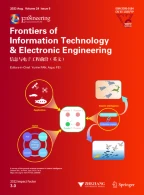Abstract
Fast and accurate extraction of vascular structures from medical images is fundamental for many clinical procedures. However, most of the vessel segmentation techniques ignore the existence of the isolated and redundant points in the segmentation results. In this study, we propose a vascular segmentation method based on a prior shape and local statistics. It could efficiently eliminate outliers and accurately segment thick and thin vessels. First, an improved vesselness filter is defined. This quantifies the likelihood of each voxel belonging to a bright tubular-shaped structure. A matching and connection process is then performed to obtain a blood-vessel mask. Finally, the region-growing method based on local statistics is implemented on the vessel mask to obtain the whole vascular tree without outliers. Experiments and comparisons with Frangi’s and Yang’s models on real magnetic-resonance-angiography images demonstrate that the proposed method can remove outliers while preserving the connectivity of vessel branches.
Similar content being viewed by others
References
Adel M, Moussaoui A, Rasigni M, et al., 2010. Statistical-based tracking technique for linear structures detection: application to vessel segmentation in medical images. IEEE Signal Process Lett, 17(6):{p.555–558}. https://doi.org/10.1109/LSP.2010.2046697
Becker C, Rigamonti R, Lepetit V, et al., 2013. Supervised feature learning for curvilinear structure segmentation. Int Conf on Medical Image Computing and Computer-Assisted Intervention, p.526–533. https://doi.org/10.1007/978-3-642-40811-3_66
Bogunovic H, Pozo JM, Villa-Uriol MC, et al., 2011. Automated segmentation of cerebral vasculature with aneurysms in 3DRA and TOF-MRA using geodesic active regions: an evaluation study. Med Phys, 38(1):210–222. https://doi.org/10.1118/l.3515749
Chan MY, Wu YC, Qu HM, et al., 2006. MTP-guided vascular image visualization with multi-dimensional transfer function. 24th Computer Graphics Int Conf, p.372–384. https://doi.org/10.1007/11784203_32
Chen L, Mossa-Basha M, Balu N, et al., 2018. Development of a quantitative intracranial vascular features extraction tool on 3DMRA using semiautomated open-curve active contour vessel tracing. Magn Reson Med, 79(6):{p.3229–3238}. https://doi.org/10.1002/mrm.26961
Chowriappa A, Kesavadas T, Mokin M, et al., 2013. Vascular decomposition using weighted approximate convex decomposition. Int J Comput Assist Radiol Surg, 8(2):{p.207–219}. https://doi.org/10.1007/sll548-012-0766-6
Ding Y, Ward WOC, Wasterlid T, et al, 2014. Three- dimensional vessel segmentation using a novel combinatory filter framework. Phys Med Biol, 59(22):{p.7013–7029}. https://doi.org/10.1088/0031-9155/59/22/7013
El-Baz A, Farag AA, Gimel’farb G, et al., 2005. Automatic cerebrovascular segmentation by accurate probabilistic modeling of TOF-MRA images. Int Conf on Medical Image Computing and Computer-Assisted Intervention, p.34–42. https://doi.org/10.1007/11566465_5
El-Baz A, Elnakib A, Khalifa F, et al., 2012. Precise segmentation of 3-D magnetic resonance angiography. IEEE Trans Biomed Eng, 59(7):{p.2019–2029}. https://doi.org/10.1109/TBME.2012.2196434
Forkert ND, Schmidt-Richberg A, Fiehler J, et al, 2013. 3D cerebrovascular segmentation combining fuzzy vessel enhancement and level-sets with anisotropic energy weights. Magn Reson Imag, 31(2):{p.262–271}. https://doi.Org/10.1016/j.mri.2012.07.008
Frangi AF, Niessen WJ, Vincken KL, et al, 1998. Multiscale vessel enhancement filtering. 1st Int Conf on Medical Image Computing and Computer-Assisted Intervention, p.130–137. https://doi.org/10.1007/BFb0056195
Hannink J, Duits R, Bekkers E, 2014. Vesselness via multiple scale orientation scores, https://arxiv.org/abs/1402.4963
Hibet-Allah O, Hajer J, Kamel H, 2016. Vascular tree segmentation in MRA images using Hessian-based multiscale filtering and local entropy thresholding. 2nd Int Conf on Advanced Technologies for Signal and Image Processing, p.325–329. https://doi.org/10.1109/ATSIP.2016.7523100
Kumar RP, Albregtsen F, Reimers M, et al., 2015. Blood vessel segmentation and centerline tracking using local structure analysis. 6th European Conf of the Int Federation for Medical and Biological Engineering, p. 122–125. https://doi.org/10.1007/978-3-319-11128-5_31
Rajeswari J, Jagannath M, 2017. Advances in biomedical signal and image processing-a systematic review. Inform Med Unlocked, 8:13–19. https://doi.org/10.1016/j.imu.2017.04.002
Sulayman N, Al- Mawaldi M, Kanafani Q, 2016. Semiautomatic detection and segmentation algorithm of saccular aneurysms in 2D cerebral DSA images. Egypt J Radiol Nucl Med, 47(3):{p.859–865}. https://doi.org/10.1016/j.ejrnm.2016.03.016
Tian Y, Duan FQ, Lu K, et al., 2013. A flexible 3D cerebrovascular extraction from TOF-MRA images. Neuro-computing, 121:392–400. https://doi.org/10.1016/j.neucom.2013.05.031
Wang R, Li C, Wang J, et al., 2015. Threshold segmentation algorithm for automatic extraction of cerebral vessels from brain magnetic resonance angiography images. J. Methods, 241:30–36. https://doi.org/10.1016/jjneumeth.2014.12.003
Wozniak T, Strzelecki M, 2015. Segmentation of 3D magnetic resonance brain vessel images based on level set approaches. Signal Processing: Algorithms, Architectures, Arrangements, and Applications, p. 56–61. https://doi.org/10.1109/SPA.2015.7365133
Yang GY, Kitslaar P, Frenay M, et al., 2012. Automatic centerline extraction of coronary arteries in coronary computed tomographic angiography. Int J Cardiov Imag, 28(4):{p.921–933}. https://doi.org/10.1007/sl0554-011-9894-2
Yang JZ, Ma S, Sun Q, et al., 2014. Improved Hessian mul-tiscale enhancement filter. Biomed Mater Eng, 24(6): 3267–3275. https://doi.org/10.3233/BME-141149
Yang X, Cheng KTT, Chien A, 2014. Accurate vessel segmentation with progressive contrast enhancement and Canny refinement. Asian Conf on Computer Vision, p.1–16. https://doi.org/10.1007/978-3-319-16811-1_1
Zhao SF, Zhou MQ, Jia TR, et al, 2014. Multi-branched cerebrovascular segmentation based on phase-field and likelihood model. Comput Graph, 38:239–247. https://doi.org/10.1016/j.cag.2013.11.004
Author information
Authors and Affiliations
Corresponding author
Ethics declarations
Yun TIAN, Zi-feng LIU, and Shi-feng ZHAO declare that they have no conflict of interest.
Additional information
Project supported by the National Natural Science Foundation of China (Nos. 61472042 and 61802020), the Beijing Natural Science Foundation, China (No. 4174094), and the Fundamental Research Funds for the Central Universities, China (No. 2015KJJCB25)
Rights and permissions
About this article
Cite this article
Tian, Y., Liu, Zf. & Zhao, Sf. Vascular segmentation of neuroimages based on a prior shape and local statistics. Frontiers Inf Technol Electronic Eng 20, 1099–1108 (2019). https://doi.org/10.1631/FITEE.1800129
Received:
Accepted:
Published:
Issue Date:
DOI: https://doi.org/10.1631/FITEE.1800129
